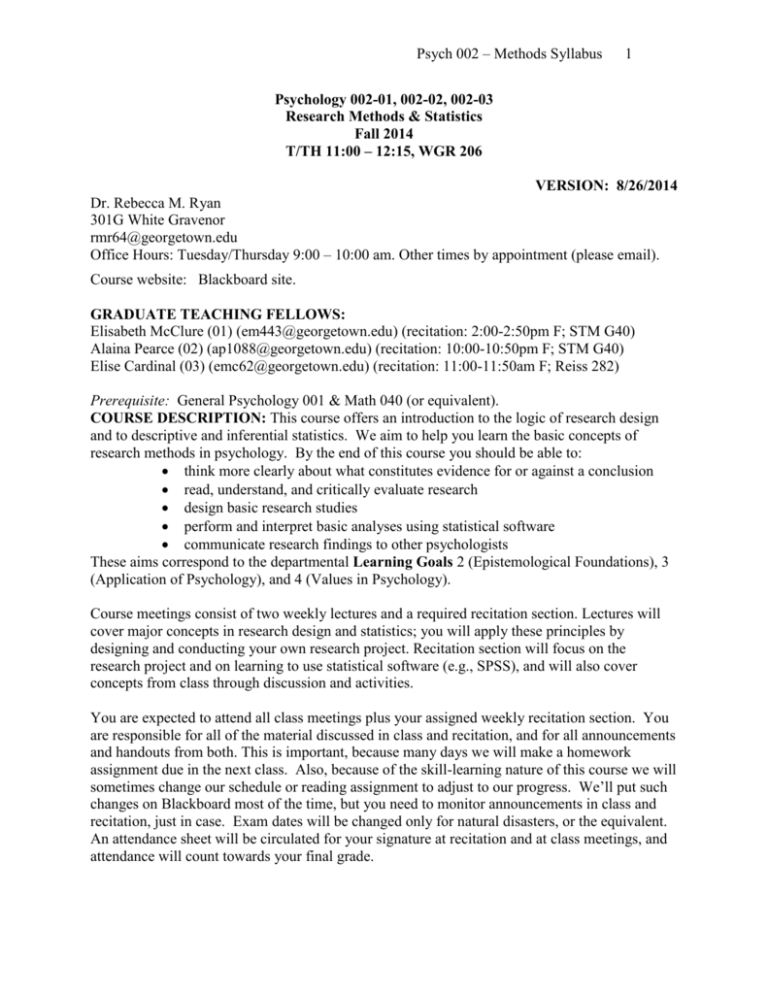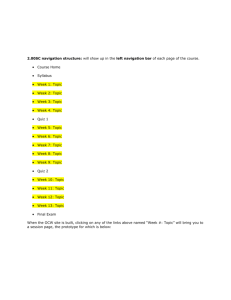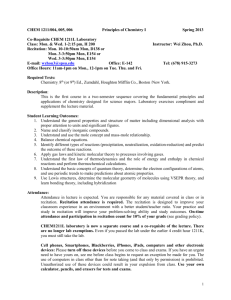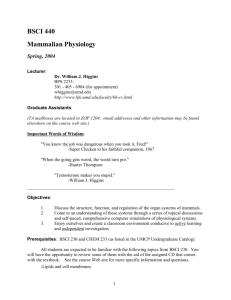Psychology 002-01 & 002-02
advertisement

Psych 002 – Methods Syllabus
1
Psychology 002-01, 002-02, 002-03
Research Methods & Statistics
Fall 2014
T/TH 11:00 – 12:15, WGR 206
VERSION: 8/26/2014
Dr. Rebecca M. Ryan
301G White Gravenor
rmr64@georgetown.edu
Office Hours: Tuesday/Thursday 9:00 – 10:00 am. Other times by appointment (please email).
Course website: Blackboard site.
GRADUATE TEACHING FELLOWS:
Elisabeth McClure (01) (em443@georgetown.edu) (recitation: 2:00-2:50pm F; STM G40)
Alaina Pearce (02) (ap1088@georgetown.edu) (recitation: 10:00-10:50pm F; STM G40)
Elise Cardinal (03) (emc62@georgetown.edu) (recitation: 11:00-11:50am F; Reiss 282)
Prerequisite: General Psychology 001 & Math 040 (or equivalent).
COURSE DESCRIPTION: This course offers an introduction to the logic of research design
and to descriptive and inferential statistics. We aim to help you learn the basic concepts of
research methods in psychology. By the end of this course you should be able to:
think more clearly about what constitutes evidence for or against a conclusion
read, understand, and critically evaluate research
design basic research studies
perform and interpret basic analyses using statistical software
communicate research findings to other psychologists
These aims correspond to the departmental Learning Goals 2 (Epistemological Foundations), 3
(Application of Psychology), and 4 (Values in Psychology).
Course meetings consist of two weekly lectures and a required recitation section. Lectures will
cover major concepts in research design and statistics; you will apply these principles by
designing and conducting your own research project. Recitation section will focus on the
research project and on learning to use statistical software (e.g., SPSS), and will also cover
concepts from class through discussion and activities.
You are expected to attend all class meetings plus your assigned weekly recitation section. You
are responsible for all of the material discussed in class and recitation, and for all announcements
and handouts from both. This is important, because many days we will make a homework
assignment due in the next class. Also, because of the skill-learning nature of this course we will
sometimes change our schedule or reading assignment to adjust to our progress. We’ll put such
changes on Blackboard most of the time, but you need to monitor announcements in class and
recitation, just in case. Exam dates will be changed only for natural disasters, or the equivalent.
An attendance sheet will be circulated for your signature at recitation and at class meetings, and
attendance will count towards your final grade.
Psych 002 – Methods Syllabus
2
PLEASE ATTEND THE RECITATION SECTION YOU REGISTERED FOR. YOU
CANNOT SUBSTITUTE RECITATION SECTIONS.
REQUIRED TEXTS:
Graziano, A. M., & Raulin, M. L. (2013). Research methods: A process of inquiry (8th Ed).
Boston: Allyn & Bacon.
Nolan, S. A., & Heinzen, T. E. (2014). Essentials of statistics for the behavioral sciences (2nd
Edition). New York: Worth.
*Note, you may purchase either the online only (Statsportal) or text version of Nolan and
Heinzen. Both are available through the bookstore. The online only versions are less expensive.
COURSE REQUIREMENTS:
Exams (180 total points). There will be four exams, on the dates indicated on the class
schedule; the Final Exam (#4) will occur during finals. The first three will emphasize material
covered since the last exam, but questions concerning earlier material will be included as well.
Thus, the exams are cumulative because the material is. The final exam will test all material
covered during the course, so it is fully cumulative. Should it be necessary to cancel an exam due
to weather (e.g., official GU cancellation), the exam will be given in the immediately following
class. Check Blackboard and email in such circumstances. All exams are worth 60 points,
however, your lowest score of the first three will be dropped when calculating your final grade.
Note that exams will focus on skills/facts learned from class, Graziano and from the Williams
text. Not all of the design concepts covered in the Graziano text will be covered during lecture,
however, all of the concepts covered in Graziano could be covered on a test. Thus, if there is a
concept you do not understand in Graziano that falls within the assigned reading, please ask me
or your recitation TF to clarify the concept. Also note, most exam questions will not test your
definitional knowledge of design or statistical concepts or techniques. Rather, most exam
questions will assume your knowledge of concepts or techniques and require you to apply your
understanding to a novel circumstance. Do not simply memorize definitions or formulae.
Understand them.
Lecture-Based Quizzes (20 points). There will be very short (1-2 questions) quizzes after each
Thursday lecture (with some exceptions) testing you on concepts learned in class that week.
Each quiz will be worth very few points. The goal will be to highlight concepts you may not
have fully grasped during lecture to provide areas of study focus for upcoming exams.
Recitation-Based Assignments (20 points). You will receive a separate schedule for your
recitation sections with topics and details of assignments on it. There will be other supporting
documents on Blackboard.
Research Project (180 points). You must complete a research project in which you apply what
you have learned in this course to propose, design, conduct, analyze, and write up a study
addressing a question of your choice. A lot of your recitation section time will be devoted to
learning related to the project. We encourage you to work with one to two other students on the
project. Typically this enables you to test more subjects, and you will have colleagues with
whom you can design your study and think about what your results mean. If you do work with
Psych 002 – Methods Syllabus
3
one or two other people, each member of the group must nonetheless turn in a separate proposal,
introduction and methods, results, and discussion. Thus, each member will receive independent
grades on each part. Although members of the same group will be describing the same research
question, procedure, and results, each must work independently to demonstrate their
understanding and application of research methods and statistics.
The research project is the major assignment in the course and one to be worked on all
semester. Begin immediately to think of possible topics/questions. You should be asking
yourself after every lecture and every reading assignment, “How does this material affect my
approach to the research problem I have chosen?” You should be applying everything you learn
in this course to preparing the project. Also you should begin searching for previously published
research on your topic to help you design your own very early in the semester.
Proposal (45 points). Two of your peers, your TF, and I will read this proposal, and a
group of your peers will advise me as to whether or not the proposed study is ethical and
methodologically sound. So provide as much detail as possible in the space available. To begin,
pick two starting papers on your chosen topic, at least one of which that has been published
within the past 5 years. These papers must be empirical articles, not review papers or chapters.
Your research proposal should propose an original experiment that extends or challenges the
prior studies. It should be written in the future tense because it is describing an experiment that
has yet to be run. Photocopy your starting papers and attach them to your submission.
Keep your “paper trail” (i.e. all your photocopies articles and notes) until your research proposal
is returned.
The page limit for the proposal (not including the reference section or cover page) is 7
double-spaced type-written pages using 12 point font and at least 1 inch margins on all
sides. I will not read any text beyond the 7 pages. This will mean that you will have to be
very concise and precise. Organization and clarity do matter for the proposal and both drafts.
Always number pages and proofread.
The proposal should include the following sections with the following labels. You should write
in full sentences and paragraphs; this is not an outline.
-
Cover page (not counted in page limit) - Title. Here you state the tentative title of
your project and your name as author. (Title should be the same for all team
members).
-
Objective. This contains approximately 2 - 4 sentences explaining the purpose of
your study, what you are going to do, and why.
-
Introduction. Write an introduction (approx. 2 pages) in which you review the
general topic area, summarize relevant literature, culminating in a critical evaluation
of one particular issue that could be addressed empirically. Cite and discuss your
starting papers and other relevant papers that you have found during your literature
search. You must cite at least 10 articles, including the 2 starting papers. At least 7 of
these must be original empirical articles, while 3 may be review articles or chapters or
citations for measures. Clarify what gap in the literature your study would fill and
Psych 002 – Methods Syllabus
4
why that gap is important to fill. Your literature review should also establish the
historical context of previous work, and your proposed study, and the theories upon
which prior work has drawn.
-
Hypothesis. State your hypothesis. Your hypothesis should follow logically from a
theoretical framework and empirical support provided in your literature review. It
should provide a hypothetical answer to the question you posed at the end of your
review (and in your objective) grounded in theory and prior research.
-
Proposed Method. This method section should include separate participants,
apparatus, design, and procedure sections (approx. 3 pages). Participants should
include proposed subject recruitment, and apparatus should include description of
materials your experiment will use, including any questionnaires or surveys. The
design should specify dependent and independent variables you will be using and the
number of factors and levels (in design notation), if applicable. It should also outline
methods of control that you will be using and why (i.e. what sorts of confounds will
you be guarding against?). Also state variables that you will not be controlling.
-
Proposed data analysis. (approx. 1 page) This section should state what aspects of
your data you think will be important, and what you expect to find (i.e. what you
predict). For example, you might state how you will condense your data, and what
cells will be compared to each other. You should also outline the statistical analyses
you plan to use (e.g., ANOVA, Chi-square, t-test) given the measurement of your
dependent and independent variables and the hypotheses you aim to test. However,
you will submit a more detailed data analysis plan later in the semester.
-
Ethical Considerations. (1/2 page) This section should describe what you will do to
ensure fairness to participants and what remaining concerns you have, if any, about
the ethics of the study. You should include your informed consent procedure (and
documentation) as an appendix to the proposal.
-
References (start on a new page – these pages are not counted in page limit).
This contains a list of the articles you have cited in your paper. Again, you must cite
at least 10 articles. Use APA style.
Please turn in a total of 3 copies of your completed proposal. One of the copies should have the
title and your name on the cover page. The two remaining copies should have only the title,
without your name, to make the anonymous peer review process possible.
Peer review (20 points). After proposals are due, we will give you two proposals on
which you are to serve as the primary and secondary reviewer. You will write a brief critique of
both proposals you have been assigned, putting each review on a separate piece of paper.
Your critique of each proposal should list the title and “author number” of the proposal you are
reviewing, and your own peer review number (labeled “reviewer number”). Please turn in two
copies of each review, one with your name written next to your reviewer number. This copy will
come to me for grading and the anonymous one will go to the author of the proposal in question.
Psych 002 – Methods Syllabus
5
Your review should comment constructively on aspects of the design of the study
and outline in a few sentences the features of the study that are relevant for deciding on
soundness of design and fairness to participants. You should indicate whether you think
the study is ethical and why or why not. If you think it isn’t ethical, try to suggest alternatives
or ways of fixing it. Write this review so that it is sufficient to explain the study to the review
group (most of whom won’t have read it) and so that they will be informed enough to vote on
whether or not the study is methodologically sound and acceptable ethically. For the proposal on
which you are the primary reviewer, your written comments will serve as notes for your
presentation to the group.
On Peer Review day, the primary reviewer will provide the summary described in the
previous paragraph, the secondary reviewer will agree or disagree with specific points, and the
group will discuss and then vote on whether the study is acceptable. The outcome of this vote
should be recorded on the review and that will go to author (the one without the reviewer’s
name). The above procedure of the peer group review discussion is based on that used in the
NIH “study sections”, the peer review groups who review the scientific merit of grant proposals
submitted to the NIH for funding.
Components of Final Paper for Research Project:
Introduction/Methods (40 points). This should follow the format outlined in your APA
style writing guide (see Research Project Links in the external links page of Blackboard) and the
“Ingredients of an Introduction” handout. The page limit for the text is 6 double-spaced typewritten (not including the references or appendices). You should include an Appendix containing
a copy of any questionnaire or instructions you gave your participants or stimuli that you will
present. Remember though that the paper itself should contain enough information that the
reader would not need to have the Appendix to understand your study.
Data Analysis Plan (10 points). (1 page) This assignment helps insure that you have a
sound plan for analyzing the data you’ve been collecting. You should detail step by step how you
will describe your data and how you will test your hypotheses statistically. Begin with
descriptive statistics. List the measures of central tendency, shape, and spread you will report in
describing your dependent variable(s). List any other important descriptive statistics you will
report about your sample (e.g., % male/female; mean age). Next, clarify how you will test your
hypotheses statistically, which inferential method you will use (e.g., ANOVA, independent
samples t-test, chi-square) and exactly how you will run that test (which groups you will
compare on which dependent variables, etc.). Provide a clear rationale for your choices. To
insure that you know how to conduct these analyses in SPSS, write the syntax you will use to run
the analyses. Include notes before each command explaining what the command will tell you/do.
You should append the SPSS syntax to the data analysis plan.
Final Results plus Discussion (45 points). (5 pages) As you can see, the project is
structured as a series of assignments in which each section of the final paper are graded and
receive feedback. Just as your Introduction and Method benefit from revisions you make as a
result of feedback on your proposal, and from what you have learned subsequently in the course,
Psych 002 – Methods Syllabus
6
your final Results should incorporate feedback from your draft Results (not a graded assignment,
but part of your recitation grade for participation). Your Discussion will provide the “take home
message” of your study. In it, you should summarize your results, state whether they support
your hypotheses, and interpret why or why not. Qualify the limitations of your study and provide
any alternative explanations for your findings.
Poster presentation (20 points). You will share the final outcome of your research
project with your class as well as members of the Psychology Department by displaying your
results in the form of a “poster”. These posters will be displayed on walls of the hallway on the
3rd floor of WGR. This is a common method of presenting research at academic conferences. A
separate handout with details and directions for the entire project will be provided early in the
semester.
**Please note that the penalty for late submission of components of the project is one step
deducted (e.g., B+ to B) if you turn it in one day late, one letter grade (e.g., B+ to C+) deducted
if you turn it in between two and four days late, and an additional letter grade deducted for each
additional week thereafter.
Your Course Grade. Your course grade will depend equally on lecture assessments (exams and
lecture homework) and on assignments related to the final project. The details are as follows:
Lecture Assessments (50% of total)
Best 2 of first 3 exams: 15% (60 pts) each
Final exam (during finals): 15% (60 pts)
Lecture-based quizzes: 5% (20 pts)
Project/Recitation Assessments (50% of total):
Homework/Attendance/Participation: 5% (20 pts)
Proposal (7 pp): 11.25% (45 pts)
Peer Review (2 pp): 5% (20 pts)
Introduction/Method (6 pp): 10% (40 pts)
Data Analysis plan (1 p (+ SPSS syntax)): (10 pts)
Results + Disc (5 pp): 11.25% (45 pts)
Poster Session: 5% (20 pts)
The final grade will be computed as follows: (Total points/400)*100
The following grade scale will be used:
A course letter grade will be assigned as follows. If your average falls between categories, the
lower grade will be awarded, though I will take class participation and attendance into account
for borderline cases. A 93-100%; A- 90-92; B+ 87-89; B 83-86; B-80-82; C+ 77-79; C 73-76;
C- 70-72; D+67-69; D 60-66; F <60.
Psych 002 – Methods Syllabus
7
Research Methods & Statistics Class Schedule – Fall 2014
DATE
Aug
28 TH
Research Design
Sept
2 T
4 TH
9 T
CLASS TOPIC
Introduction and organization
READING
GR Ch. 1
Research Process and Types of studies
Variables (types, measurement, reliability)
Limits: Internal and External validity
GR Ch. 2
GR Ch. 3, 4
GR Ch. 7, 8
11 TH Limits: Internal and External validity
16 T
Study design: Between and Within subjects
18 TH Factorial Design
23 T
Main effects and interactions
25 TH Main effects and interactions
30 T
Ethics in research
Oct
2 TH EXAM #1 (covering up to Ethics)
Descriptive Statistics
7 T
Distributions, central tendency and variability
9 TH Normal Distributions, z-scores
14 T
IN CLASS PEER REVIEW
16 TH Hypothesis testing: z-test, p-values
Inferential Statistics
21 T
Confidence intervals and power
Nov
Dec
23 TH One sample t-test
28 T
One sample t-test
30 TH T-test for two samples
EXAM #2 (covering Distributions to one
4 T
sample T-test)
6 TH T-test for two samples
11 T
ANOVA (f-test)
13 TH ANOVA (f-test)
18 T
ANOVA/ Interactions and main effects
21
25
27
2
4
13
TH
T
TH
T
TH
SA
ANOVA/ Interactions and main effects
The chi-square
THANKSGIVING BREAK
EXAM #3 (covering up to Nov 21)
POSTER SESSION (WGR 3rd Floor)
FINAL EXAM (4-6pm)
GR Ch. 9
GR Ch. 10, 11
GR Ch. 12
ASSIGNMENTS
Question Due in Recitation
Revised Ques + Articles in
Recitation
Annotated Bibliography
Due in Recitation
Annotated Outline Due in
Recitation
NH 1, 2, 4
NH 6
PROPOSAL DUE in
Lecture
NH 7
NH 8
NH 9, pp.197-210
Online NIH course due on
19th in recitation
NH 9, pp.210-219
INTRO & METHODS DUE
NH 10
NH 11
NH 12
DRAFT DATA ANALYSIS
PLAN due in recitation
NH 15
RESULTS & DISC DUE
Psych 002 – Methods Syllabus
8
GENERAL COMMENTS
Knowledge versus Understanding. Be aware of the difference between knowledge and
understanding, and the difference between understanding and wisdom. These are all different,
but they are related. You must demonstrate knowledge and understanding to receive full credit.
Responsibility. You are responsible for your work in this class. This includes arriving
sufficiently early to be seated and ready for class, peer review day, exams as well as turning in
homework on time. Responsibility also means dealing with the consequences of your actions or
misfortunes (including those related to your research project – research can be messy and
frustrating!). In my class, I don’t give grades, you earn them.
Many of you will ask yourself at some point during the semester why we are covering some of
the material you already covered in Math 040. I direct you first to the distinction between
knowledge and understanding above. Math 040 provided basic knowledge of (some of the)
statistical concepts we will use in this class. Here, your knowledge will deepen to the level of
understanding, you will learn about more advanced statistics (e.g., ANOVA), and you will learn
to APPLY that understanding to psychological research. That is a central aim of this class.
For those unconvinced by the argument above, PLEASE READ THE FOLLOWING
ARTICLE, which has been annotated for context:
Arthur Michelson: The precision of math, like poetry, gets to heart of things
Arthur Michelson, who teaches at Beechwood School in Menlo Park, Calif., wrote this article for
the Los Angeles Times.
December 30, 2004 MICHELSON1230
American middle school {college students} don't much care that they're worse at math than their
counterparts in Hong Kong and Finland. "I don't need it," my students say. "I'm gonna be a
basketball star." Or a beautician, or a car mechanic, or a singer {or work on Wall Street}.
It's also hard to get much of a rise out of adults over the fact, released earlier this year, that the
United States ranked 28th out of 41 countries whose middle school students' math skills were
tested by the Organization for Economic Cooperation and Development. So what if we're tied
with Latvia, while nations such as Japan and South Korea leave us in the dust? After all, when
was the last time you used algebra?
But math is not just about computing quadratic equations, knowing geometric proofs or
balancing a checkbook. And it's not just about training Americans to become scientists.
It has implicit value. It is about discipline, precision, thoroughness and meticulous analysis.
It helps you see patterns, develops your logic skills, teaches you to concentrate and to
separate truth from falsehood. These are abilities and qualities that distinguish successful
people.
Psych 002 – Methods Syllabus
9
Math helps you make wise financial decisions, but also informs you so you can avoid false
claims from advertisers, politicians and others. It helps you determine risk. Some examples:
• If a fair coin is tossed and eight heads come up in a row, most adults would gamble that the
next toss would come up tails. But a coin has no memory. There is always a 50-50 chance. See
you at the casino?
• If you have no sense of big numbers, you can't evaluate the consequences of how government
spends your money. Why should we worry? Let our kids deal with it. ...
• Enormous amounts of money are spent on quack medicine. Many people will reject sound
scientific studies on drugs or nutrition if the results don't fit their preconceived notions, yet they
might leap to action after reading news stories on the results of small, inconclusive or poorly run
studies.
• After an airplane crash, studies show that people are more likely to drive than take a plane in
spite of the fact that they are much more likely to be killed or injured while driving. Planes are
not like copycat criminals. A plane is not more likely to crash just because another recently did.
In fact, the most dangerous time to drive is probably right after a plane crash because so many
more people are on the road.
The precision of math, like poetry, gets to the heart of things. It can increase our awareness.
Consider the Fibonacci series, in which each number is the sum of the preceding two, (0, 1, 1, 2,
3, 5, 8, 13 ...). Comparing each successive pair yields a relationship known as the Golden Ratio,
which often shows up in nature and art. It's the mathematical underpinning of what we consider
beautiful. You'll find it in the design of the Parthenon and the Mona Lisa, as well as in human
proportion; for instance, in the size of the hand compared with the forearm and the forearm to the
entire arm. Stephen Hawking's editor warned him that for every mathematical formula he wrote
in a book, he would lose much of his audience. Yet more than a little is lost by dumbing things
down.
It is not possible to really understand science and the scientific method without understanding
math. A rainbow is even more beautiful and amazing when we understand it. So is a lightning
bolt, an ant or ourselves.
Math gives us a powerful tool to understand our universe. I don't wish to overstate: Poetry,
music, literature and the fine and performing arts are also gateways to beauty. Nothing we study
is a waste. But the precision of math helps refine how we think in a very special way.
How do we revitalize the learning of math? I don't have the big answer. I teach middle school
{college} and try to find an answer one child {student} at a time. When I can get one to say,
"Wow, that's tight," I feel the joy of a small victory.







